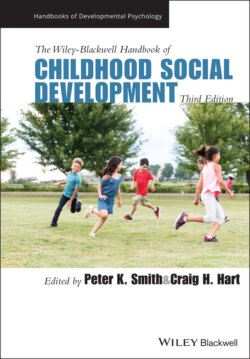Читать книгу The Wiley-Blackwell Handbook of Childhood Social Development - Группа авторов - Страница 92
Child Socialization through Social Change
ОглавлениеSocialization is a dynamic process with institutions, as social formations, and agents of socialization being in constant flux. Children’s interactions with parents, schools, and friends shape and are shaped by significant social changes, locally and globally, whose rate has been accelerating over the last decades through globalization, inequality, and multiple crises (e.g., financial, mass migration, Covid‐19). Crises used to be points of rupture, deviations from the norm, but now they have become the “new norm.” External changes are reflected in the role of families in modern societies and the socialization process inside the family environment. From the 1950s to nowadays, the family’s functions and forms have been modified; despite (or because of) these changes, the family continues to play a fundamental role in children's socialization (Höppner, 2017; Rollins & Hunter, 2013).
Global social changes have affected child socialization patterns in a multitude of ways. Family structures have become more egalitarian over time where children are encouraged to take plural perspectives with an emphasis on child voice and centeredness. Learning has also moved from being socially guided to independent learning. Children are socialized to be more experimental and curious, more into self‐expression and independent thinking, interacting via technology, and spending more time indoors than outdoors. An increasing emphasis is placed on parents and children developing emotional bonds articulated in attachment discourses, with parents being actively encouraged to be attuned and responsive to children’s feelings (Chen et al., 2010) and raise their self‐esteem and self‐confidence (Harkness et al., 2000). Furthermore, changes in the ethics of care are seen in shifts from expectations of family obligation to expectations of individual development and achievement (Kagitcibasi & Ataca, 2005); and from in‐person social interaction to technologically mediated social interaction (Hartas, 2020). These general patterns in child socialization find different manifestations in diverse social and cultural contexts.
Political and economic changes in the last decades of the 20th century have challenged the state as the arbiter of social and economic rights and public services to families and schools with parents and teachers being increasingly viewed as consumers and investors. The neoliberal organization of society is reflected in discourses of individual freedom, personal responsibility, privatization, and outsourcing of public services and care, and a free market that escapes political regulation. It is also reflected in the commodification of care and the creation of new markets (e.g., parenting experts, family intervention programs) that permeate aspects of life that were thought to be non‐marketable. This restructuring has led to public sector reduction and social policy reforms that have implications for institutions (e.g., family, schools) and agents of child socialization by giving rise to the politicization of parents and new forms of accountability for schools and teachers.
Global social changes in general, and the transformation of the public domain into a quasi‐market in particular, have permeated and reshaped child socialization processes by scaling them down to the level of interpersonal interactions with the primary caregiver, mainly mothers (Rose & Abi‐Rached, 2013). As the “social” is being considerably diminished, its agents such as family, parents, and schools have been dismantled and reconstructed in accordance with market values and orientations. Socialization has become a process of acquisition of structures, behaviors and tastes, and cognition, language, and emotions within the family, with parent–child interactions playing a lead role in consolidating this process. It is thus fitting to view socialization through family policy changes and the politicization of parenting and ethics of care; the creation of partnerships and new forms of relating to schools and teachers; the shrinking of families’ public and social spaces, and children’s sense of place, as well as through social‐class lenses.
